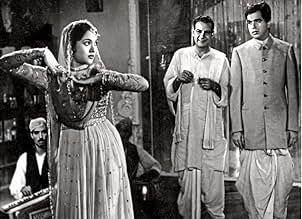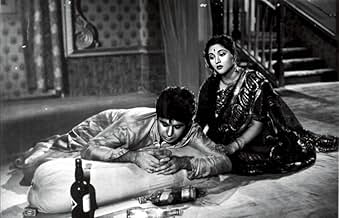I'm writing - and viewed, this, as an English non-Indian, who simply loves film and is venturing from more obvious World Cinema, into the more obscure and possibly more rewarding.
So, I'm more concerned with the story than who's playing whom and such. I came across the story, Devdas, via the 2002, very colourful and (at the time, may still be the case) most expensive Indian film, which is a feast to both eye and ear. I'll review that one, once I've re-watched my new DVD of it, having only seen on TV.
The universal and accessible story, written as early as 1917 is of two childhood sweethearts - Parvati and the titular Devdas, who grow up but go their separate ways. Devdas flees to Calcutta and seeking the high- life, frequents a brothel and starts drinking; to the extent that he comes alcoholic. She marries a wealthy husband. They both regret their parting and long for what could have been. Devdas befriends a pretty prostitute - Chandramukhi - who desperately wants to love the Devdas that she inwardly sees, but cannot reach. His loves are for his childhood sweetheart - and the alcohol, only. Add family issues and you've got a nice pot-boiler of emotion, drama and pathos throughout the 160 minute run-time.
Many think, wrongly, that Indian cinema is nothing but Bollywood - lightweight singing and dancing and that serious issues on Life are either treated in a dismissive way, or not at all. In many ways, this story could be Shakespearian, or made for the Golden era of Hollywood. What makes it endlessly fascinating is of course the different culture, from marriage and fidelity to the simple poetic beauty in the landscape and costume.
There is some singing and dancing in this 1955 black & white version, but little compared to a Bollywood production and much of what there is are the rituals of the working ladies that venture into Devdas' sordid existence.
Naturally, this monochrome - and much earlier film than the 2002 one, is poorer in picture and sound quality. Mine (cover exactly as shown) had a varying faint green/olive colour cast, had quite a few blemishes picked up through time and was slightly soft. The sound is OK, if you're not fussy. However, I know that this quality is typical, for Indian film of this period. However, one gets used to it and almost comforted by it, being more intense, somehow. At least is doesn't look like a video- transfer, thankfully.
From what I gather, many agree that Bimal Roy's film, here, is the definitive adaptation, though it was made earlier, the first of which was in 1928! For popularists and lovers of colour and spectacle, go for the 2002 glossy version. If the story and the acting and a purer form of beauty is what you're after, then this one will have you enthralled. Though the film itself is a four and half starrer, I've not rounded it up, due to transfer quality issue.
































